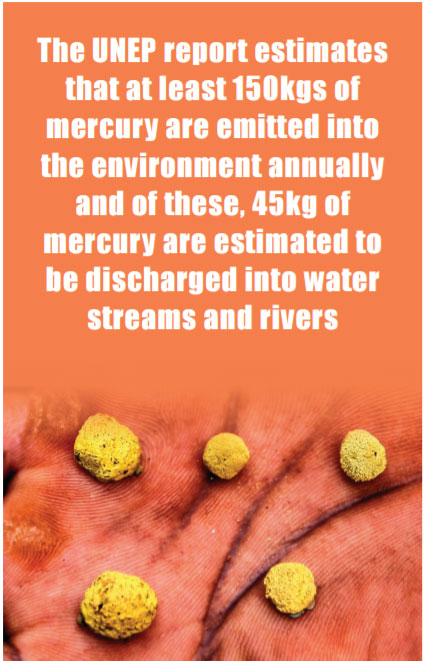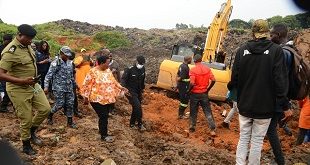
Nyakecho says mercury, which is a poisonous heavy metal, lets off hazardous fumes when burnt. Should a pregnant mother come into contact with these fumes, Nyakecho says, it could lead to miscarriage or giving birth to a deformed baby.
Dr. David Basangwa, a senior psychiatrist and executive director of Butabika National Referral and Teaching Mental Hospital told The Independent on June 12 that once a person is exposed to heavy metals like mercury, these eventually find their way to the brain and once they are there, the victim could suffer from chronic problems like dementia.
“There can also be actual state of confusion; it can be acute for someone who has taken in heavy doses but it can also be a slow onset where the mercury accumulates in the body over time.”
“The signs to look out for are restlessness and abnormal perceptions (hallucinations),” says Basangwa.
Most of these ailments are cumulative, only becoming evident in the medium to long term; most miners have chosen to ignore them, partly because they have no alternative employment, but also because most do not appreciate the gravity of the problem.
Basangwa says the people who burn the gold usually take in large doses of mercury because they directly inhale the metals but those who may get it after eating food that is contaminated with mercury take it in slowly and it accumulates over time.
Environmental danger
A 2012 report authored by UNEP titled, “Analysis of formalisation approaches in the artisanal and small-scale gold mining sector experiences: A case study of Uganda,” detailed the constant use of mercury in the Uganda mining sector.
The UNEP report estimates that at least 150kgs of mercury are emitted into the environment annually and of these, 45kg of mercury are estimated to be discharged into water streams and rivers.
The report also notes the main environmental impact from artisanal and small scale gold miners in Uganda, related to siltation of rivers and wildcat pitting is causing localised degradation of soil and vegetation.
In Buhweju, for instance, the alluvial gold deposits are located in water catchment areas and wetlands. Since mercury is often improperly disposed of into wetlands, many of the valleys have been washed down with mercury, which contaminates water.
Despite Uganda being a signatory to the Minamata and ILO Conventions that banned the use of mercury globally, the heavy metal remains in use across Uganda’s artisanal gold mines.
Officials from the geological directorate under the Ministry of Energy and Mineral say there have been attempts to ban mercury in gold mining but the challenge is that people do not understand the dangers associated with getting exposed to mercury.
Nyakecho says it is mostly the women and children who are more exposed to the mercury. If you have a mother who is holding this mercury directly in her hands, and she is holding a baby, she is exposing her baby to the mercury.
But even when the gold is washed in the mechanized slanting panning sluice boxes and use mercury, the contaminated water ends up in the nearest water streams.
Geoffrey Kamese, the senior programmes officer, at the National Association of Professional Environmentalists (NAPE) says since mercury burns at a very low boiling point, once it is heated, it evaporates very easily into the environment and when it rains, it gets transported very fast. It ends up settling anywhere in plants and water bodies.
“That is why, although gold mining takes place atop hills, it can easily be transported into the valleys,” he says, “Mercury also has the capacity to degrade melanin and people whose skins are degraded by mercury are prone to cancers.”
On a positive note, some civil society organisations appear to be responding to the use of mercury among Ugandan artisanal mines.
For instance, ACEMP is now promoting the use of retorts during the process of burning mercury. A retort is a cast iron or steel container with an airtight cover that does not allow any fumes to escape during the burning.
In Mubende, ACEMP and ActionAid have also been working on availing safety gear (gum boots, gloves, glasses, nose caps and overalls) to miners; especially women who, Binyina says, are the most affected by the mercury exposure.
Meanwhile, NAPE in partnership with the Uganda National Association of Occupational Health (UNACOH) and the Ministry of Gender, Labour and Social Development has been raising awareness in mining camps in Mubende, Buhweju, and Namayingo on the impact of mercury on people’s health.
Kamese told The Independent that they are interesting the artisanal miners with a new method of gold mining where they can concentrate gold by gravity.
Still, Binyina says it is almost hard to wean off artisan miners off mercury. He says the only strategy would be to encourage them to upgrade from artisans into small-scale miners. That way, they would be able to use more advanced tools and mining processes and they would also become more cautious of their health and safety, he says.
 The Independent Uganda: You get the Truth we Pay the Price
The Independent Uganda: You get the Truth we Pay the Price




Have you ever thought about creating an ebook oor guest authoring
on other sites? I have a blog centered on the same information you discuss and would
really like to have you sare some stories/information.
I know my viewers would enjoy yoour work. If you are even remotely interested, feel free to
send mee an e-mail.
Can I simply sayy what a comfort to find somebody who actually knowqs what they’re discussing on the internet.
You definitely undeestand how to bring a problem to light and make it important.
More people ought to check this out and understand this side of your story.
I was surprised that you aren’t more popular since you certainly havce the gift.
This web site certainly has all the info I needed about this subject and didn’t know who to
ask.
Appreciating the persistence you put into your site and iin depth information you offer.
It’s nice to come across a blog every once in a while that
isn’t the same outdated rehashed information. Fantastic read!
I’ve bookmarked your site and I’m adding your RSS feeds to my Google account.
Good article. You should cross over here and advocate our poor minirs as well.
Nice post. I was checking constantly this blog and I’m inspired! I mainyain such info a lot.
I mainyain such info a lot.
Very useful information psrticularly the last section
I was seeking this particular information ffor a very lengthy time.
Thank you and good luck.
Howdy! Quick question that’s entirely off topic. Do you know how to make
your site mobile friendly? My weblog looks weirdd when viewing from
my iphone4. I’m trying to find a template or plugin that might be abloe to fix this problem.
If you have any recommendations, please share. With thanks!